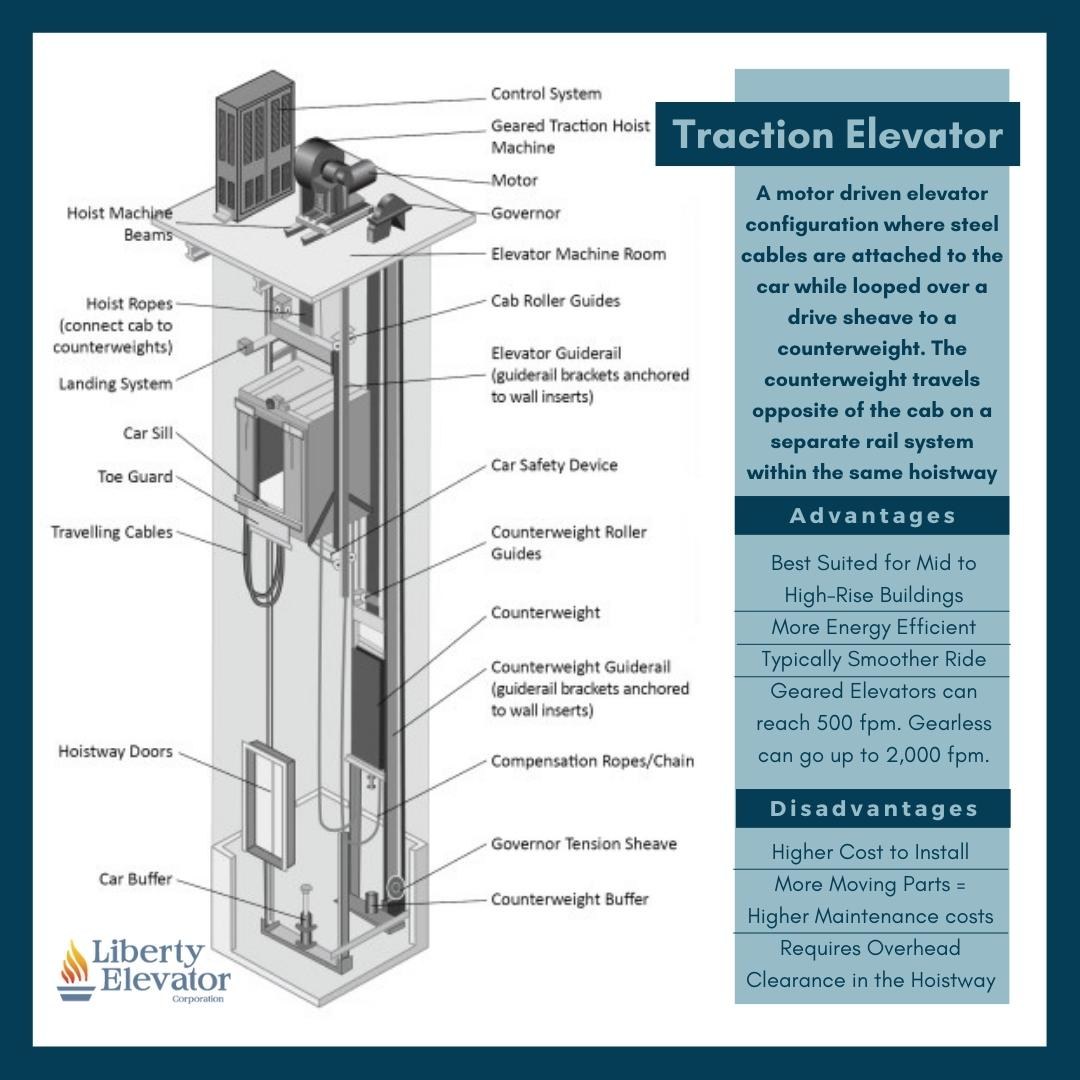A traction elevator is a type of elevator that uses a system of ropes and pulleys to move the elevator car up and down. Traction elevators are the most common type of elevator in use today, and they are typically used in high-rise buildings. In traction elevators, the elevator sheaves are the pulleys that hold the elevator cables and are responsible for the elevator's traction and lifting motion, as well as where it gets its name.
Originally put to use in ancient Greece, the physics of traction elevators has changed little throughout history. Although there have been evolutions in materials and motors, the greatest advancement was the safety brake in the 1870’s which changed the publics perception about elevators and allowed the growth of towns like New York City from sprawling hamlets into vertical metropolises.
How Does a Traction Elevator Work?
The motor turns the sheave, which rotates the ropes around the wheel. The ropes are attached to the elevator car and the counterweight. As the sheave rotates, the ropes move the elevator car up or down. The counterweight is used to balance the weight of the elevator car and helps to reduce the amount of power required to move the elevator.
The speed of a traction elevator is determined by the size of the motor and the size of the sheave. The larger the motor and the sheave, the faster the elevator will be. Geared traction elevators typically average between 200-500 feet per minute, while gearless traction elevators can easily exceed 500 fpm with a world record of 4,000 fpm.
Advantages of Traction Elevators
Traction elevators have several advantages over other types of elevators, including:
Speed: Traction elevators are the fastest type of elevator.
Capacity: Traction elevators can carry more weight than other types of elevators.
Efficiency: Traction elevators are very efficient, and they use less energy than other types of elevators.
Reliability: Traction elevators are very reliable, and they have a long lifespan.
Disadvantages of Traction Elevators
Traction elevators also have some disadvantages, including:
Cost: Traction elevators are more expensive than other types of elevators.
Noise: Traction elevators can be noisy, especially when they are moving at high speeds.
Maintenance: Traction elevators require more maintenance than other types of elevators.
Applications of Traction Elevators
Traction elevators are typically used in mid to high-rise buildings, such as office buildings, hotels, and condo/apartment complexes. They are also used in some industrial and commercial applications. Limited only by building configuration, traction elevators allow for a quick and reliable vertical transportation solution that can carry heavy loads and make buildings accessible at virtually any height.
Geared Vs. Gearless Traction Elevators
There are two main types of Traction elevators, Geared and Gearless. Although very similar, they are typically used in different applications based on the height and speed required.
Gearless Traction Elevators are built specially to be a more efficient option for high-rise buildings. These elevators have their wheel attached onto the electric motor to directly rotate the drive sheave. This results in a faster ride, with speeds that reach up to 4,000 feet per minute and can reach travel heights up to nearly 2,000 feet.
Geared Traction Elevators contain a single gearbox which is attached to an AC or DC motor. This gearbox is mounted onto the motor and will turn a wheel that rotates to move the rope or belt. The geared traction elevator is utilized for mid-rise buildings up to 300 feet in height. It also has the ability to reach speeds around 500 feet per minute, which is slower than a gearless traction elevator but still much higher than other forms of elevators.
The best way to distinguish a gearless traction elevator from a geared traction elevator is by determining where the wheel is mounted. The geared traction elevator will have its wheel attached directly to the motor.
Traction Elevator Components
| Elevator Motor | Steele Cables/Hoist Ropes/Belts |
| Elevator Sheave | Elevator Counterweight |
| Elevator Control System | Elevator Machine Room (unless MRL) |
Conclusions About Traction Elevators
Traction elevators are a type of elevator that uses a system of ropes and pulleys to move the elevator car up and down. Traction elevators are the most common type of elevator in use today, and they are typically used in mid-rise and high-rise buildings.
Liberty Has A Grip On Traction Elevators
When installing a traction elevator in new construction, modernizing your pre-existing lift or maintaining your commercial elevator, Liberty is the elevator partner you need to safely keep your traction elevator spinning. Contact Liberty today to explore the best solutions for your property’s vertical transportation needs.


